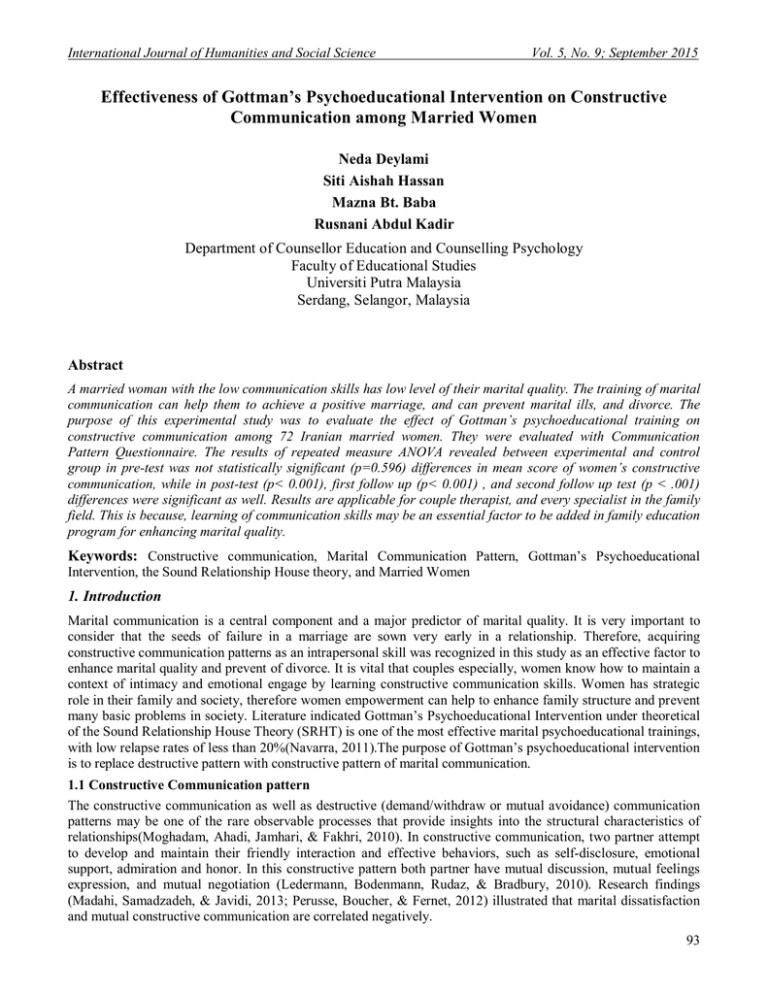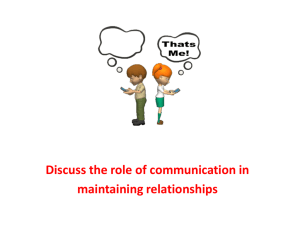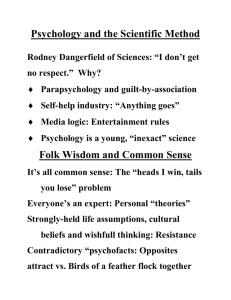Effectiveness of Gottman’s Psychoeducational Intervention on Constructive Communication among Married Women
advertisement

International Journal of Humanities and Social Science Vol. 5, No. 9; September 2015 Effectiveness of Gottman’s Psychoeducational Intervention on Constructive Communication among Married Women Neda Deylami Siti Aishah Hassan Mazna Bt. Baba Rusnani Abdul Kadir Department of Counsellor Education and Counselling Psychology Faculty of Educational Studies Universiti Putra Malaysia Serdang, Selangor, Malaysia Abstract A married woman with the low communication skills has low level of their marital quality. The training of marital communication can help them to achieve a positive marriage, and can prevent marital ills, and divorce. The purpose of this experimental study was to evaluate the effect of Gottman’s psychoeducational training on constructive communication among 72 Iranian married women. They were evaluated with Communication Pattern Questionnaire. The results of repeated measure ANOVA revealed between experimental and control group in pre-test was not statistically significant (p=0.596) differences in mean score of women’s constructive communication, while in post-test (p˂ 0.001), first follow up (p˂ 0.001) , and second follow up test (p ˂ .001) differences were significant as well. Results are applicable for couple therapist, and every specialist in the family field. This is because, learning of communication skills may be an essential factor to be added in family education program for enhancing marital quality. Keywords: Constructive communication, Marital Communication Pattern, Gottman’s Psychoeducational Intervention, the Sound Relationship House theory, and Married Women 1. Introduction Marital communication is a central component and a major predictor of marital quality. It is very important to consider that the seeds of failure in a marriage are sown very early in a relationship. Therefore, acquiring constructive communication patterns as an intrapersonal skill was recognized in this study as an effective factor to enhance marital quality and prevent of divorce. It is vital that couples especially, women know how to maintain a context of intimacy and emotional engage by learning constructive communication skills. Women has strategic role in their family and society, therefore women empowerment can help to enhance family structure and prevent many basic problems in society. Literature indicated Gottman’s Psychoeducational Intervention under theoretical of the Sound Relationship House Theory (SRHT) is one of the most effective marital psychoeducational trainings, with low relapse rates of less than 20%(Navarra, 2011).The purpose of Gottman’s psychoeducational intervention is to replace destructive pattern with constructive pattern of marital communication. 1.1 Constructive Communication pattern The constructive communication as well as destructive (demand/withdraw or mutual avoidance) communication patterns may be one of the rare observable processes that provide insights into the structural characteristics of relationships(Moghadam, Ahadi, Jamhari, & Fakhri, 2010). In constructive communication, two partner attempt to develop and maintain their friendly interaction and effective behaviors, such as self-disclosure, emotional support, admiration and honor. In this constructive pattern both partner have mutual discussion, mutual feelings expression, and mutual negotiation (Ledermann, Bodenmann, Rudaz, & Bradbury, 2010). Research findings (Madahi, Samadzadeh, & Javidi, 2013; Perusse, Boucher, & Fernet, 2012) illustrated that marital dissatisfaction and mutual constructive communication are correlated negatively. 93 ISSN 2220-8488 (Print), 2221-0989 (Online) ©Center for Promoting Ideas, USA www.ijhssnet.com Additionally, high levels of sexual problems were significantly related with more depressive symptoms only for participants who reported low levels of mutual constructive communication and high levels of demand–withdraw communication (AhmadiGatab & Khamen, 2011; Madahi et al., 2013; Milbury & Badr, 2013; Siffert & Schwarz, 2011). 1.2 Gottman’s Psychoeducational Intervention Gottman’s Psychoeducational Intervention is a research-based approach for marital therapy that considers the consequences of marital communication, either negative or positive, and has been running as a longitudinal study for over 30 years(Gottman, 2014). Gottman has used perceptual, interactive-behavioral, and physiological measures in an attempt to discern which techniques are effective for couples and which are not(Berns, Jacobson, & Gottman, 1999; Gottman, 2014). Gottman introduces three important skills in his intervention that couples need to learn for having the successful marital interaction: 1) how to prevent of conflict whenever possible by daily friendly manners and admiration behaviors, 2) how to reach an agreement and ensure positive dialogue during an unavoidable conflict, and finally, 3) how to recover and repair after conflict when they get away from each other. 2. Present Study Although, many researches have shown the promising results of Gottman’s Psychoeducational Intervention on couple, to date it has not been applied to Iranian married women. The main purpose of this quantitative study was to evaluate the effect of the Gottman’s Psychoeducational Intervention on constructive communication patterns of Iranian couples in Shiraz, Iran. It was hypothesized that Iranian married women who attend in eight sessions of intervention program could learn and apply the components of Gottman’s intervention. Consequently, their constructive communications will be improved compares with other women in control group who didn’t receive any intervention. In this research was attempted to establish whether women can apply these skills in the feature of their real life, so, feasibility and maintenance of the intervention were assessed in four times ( pre intervention, post intervention -after eight sessions- , first follow up -six months after intervention -, and second follow up - one year after intervention -). 3. Methodology 3.1 Participants By advertising, 119 married women from Shiraz- Iran enrolled in the intervention program. They were monogamy, with 1 to 7 marital years, have 25-45 years of age, without any intensive domestic violence issues and had no other psychoanalytic intervention in duration of their study. They were screened by using Dyadic Adjustment Scale to meet married women without severe positive or negative sign in their marital life. Regarding to sample size and some missing data, finally 72 married women randomly assigned into both experimental and control groups. Experimental groups (36 married women) were trained 8 sessions under the Gottman method at four points of time, while the control group (36 individuals) had no intervention. 3.2 Instruments 3.2.1Communication Pattern Questionnaire (CPQ) The CPQ were used to measure communication patterns when discussing conflict topics. CPQ (Christensen & Sullaway, 1984) is a 35-item questionnaire and an assessment tool designed to evaluate individuals’ perceptions of the dyadic patterns of problem solving behavior occurring in their relationship. The CPQ has six subscales: Constructive Communication Total amount of demand-withdraw communication, Man demand/woman withdraw communication, Woman demand/man withdraw communication, roles in demand-withdraw communication, mutual avoidance and withholding. In this study, mutual constructive communications from six subscales were considered. 4. Analyses and Results 4.1 Demographics Data analyzed for72 married women indicated that the highest frequency for both control (58.3%) and experimental (63.9%) groups belonged to age 20 to 30 years, for education level, the highest frequency for both control (38.9%) and experimental (38.9%) groups was observed in undergraduate. 94 International Journal of Humanities and Social Science Vol. 5, No. 9; September 2015 Descriptive statistics for duration of marriage illustrated that the highest frequency for both control (66.7%) and experimental (72.2%) groups was observed in 1-4 years. The results of chi square test indicated that there was no significant difference between women’s age, education, and duration of marriage in control and experimental groups. As it expected, based on the above similarity in the results, it was emphasized participants in control and experimental groups were assigned randomly and they were independent. 4.2 Inferential Statistics Hypothesis: The mean scores in constructive communication patterns for participants at T2, T3, significantly different than at T1. and T4 are As the table 2 shows, based on the mean and standard deviation, the change in mean score of women’s constructive communication was increase (except in second follow up test) with emphasizing a significantly increase during the time (p = 0.001), between two groups (p ˂ 0.001). The interaction between time and group was statistically significant as well [F (1.55, 108.65) =6.703, p ˂0.001 ŋ²= 0.087], therefore post hoc test (Bonferroni) was applied to compare the mean scores in time and groups to show this significant differences was related to which test and groups. The results of RM-ANOVA revealed between experimental and control group in pre-test was not statistically significant (p=0.596) differences in mean score of women’s constructive communication, while the differences in post-test (p˂ 0.001), first follow up (p˂ 0.001) , and second follow up test (p ˂ .001) were significant as well. Additionally, the results revealed that the difference between pre with post-test and two times follow up tests in women’s constructive communication mean score in experimental group was significant (p ˂ .001). Additionally there were no significantly differences between post-test with two times follow up tests ( p=1) and between first follow up test with the second follow up test( p=1) in experimental group as well. This result for control group revealed no significant difference between pre-test with post-test, and two times follow up and no significant differences between post-test and two times follow up (p =1), but a little increase no significantly was found between post-test and second follow up test nearly (p=0.7) and there were no significant differences in women’s constructive communication mean score in control group in first follow up compare to second follow up test (p =1) 5. Discussion Family with insufficient skills for communication and conflict management face deep pomological damages, emotional dissolution and divorce. To prevent of these problems is impossible without acquiring and learning skills. The results of this study shows women in family may benefit from Gottman’s psychoeducational intervention programs and specially, they can learn how to minimize demand–withdraw communication, deescalate negative feelings duration conflict. Furthermore results indicated that they can discuss friendly and constructively on family concerns.These findings paralleled with other research findings (Ledermann et al., 2010; Madahi et al., 2013; Milbury & Badr, 2013; Moghadam et al., 2010).Regarding to sufficient evidence that indicated the widespread implementation of Gottman’s psychoeducational intervention, (Christensen, Eldridge, Catta-Preta, Lim, & Santagata, 2006; Christensen & Shenk, 1991; Ebrahimi & Kimiaei, 2014)this study findings show Gottman’s psychoeducational intervention promote marital communication. Additionally, the results of the present study, provided evidence that mutual constructive communication pattern is a functional interaction for women in their family (Blanchard, Hawkins, Baldwin, & Fawcett, 2009; O'Riordan, 2007; Papp, Kouros, & Cummings, 2010).These results were emphasized research predictions and corroborate previous studies (AhmadiGatab & Khamen, 2011; Milbury & Badr, 2013; Navarra, 2011). In the light of this research, family counsellors and psychologists can develop their strategies for marital communication and utilize effective techniques for increasing their clients’ ability to have long lasting marriage. It is suggested to achieve positive impact on family structure; husbands are encouraged to attend in Gottman psychoeducational intervention programs as well. 6. Limitation Research limitation based on sample. It is highly likely that participants in this study had another information sources such as friends, internet, TV, formal counseling education and services, and books, which could be used to attempt to improve their marital quality. Research limitation based on the methodology. Regarding the experimental design of this research, randomization and minimization of individual differences was done, however it was impossible to rule out all confounding variables. 95 ISSN 2220-8488 (Print), 2221-0989 (Online) ©Center for Promoting Ideas, USA www.ijhssnet.com Couples in Shiraz face an unstable situation in terms of economic and social problems, and it was impossible to control all factors that may affect the emotional and mental state of the participants. Research limitation based on measurement and intervention. It is probable that some participants answered questionnaires either with low confidentially or misunderstanding about the accurate meaning of questions. Table1: Descriptive Statistics for Women’s Demographic Variables in Control and Experimental Groups Variables Age 20-30 31-40 y 41-50 y Education Secondary level Diploma Undergraduate Post graduate Duration of marriage 1-4 y 5-8 y Experimental n= 36 Control n=36 χ2 P-Value 23(63.9%) 13(36.1%) 0 0%) 21(58.3%) 15(41.7%) 0 0%) 0.23 0.63 0(0.0%) 13(36.1%) 14(38.9%) 9(25.0%) 2(5.6%) 10(27.8%) 14(38.9%) 10(27.8%) 2.44 0.49 26(72.2%) 10(27.6%) 24(66.7%) 12(33.3%) 0.26 0.61 Table 2: The Mean Comparison of Women’s CC between Experiment and Control across the time using Rm ANOVA Time (1) (2) (3) (4) EXP (n=36) Mean ± SD -0.11±11.14 7.25±6.53 7.42±6.37 6.86±5.92 Control (n=36) Mean ± SD -1.03±6.40 -0.14±8.19 -0.36±7.56 -1.3±8.77 Comparison interaction effect Between groups(a) Group*Time P value η2 F value/ (df) 6.703 0.596 0.004 (1.55,108.65) <0.01* 0.204 <0.01* 0.246 <0.01* 0.234 Comparison in 4 time P value <0.04* ETA 0.087 EXP (n=36) (1)-(2) (1)-(3) (1)-(4) (2)-(3) (2)-(4) (3)-(4) Control (n=36) P value <0.01* <0.01* 0.001* 1 1 1 Figure1. Graph for Women’s Constructive Communication across the time 96 P value 1 1 1 1 0.74 1 International Journal of Humanities and Social Science Vol. 5, No. 9; September 2015 References AhmadiGatab, T., & Khamen, A. B. Z. (2011). Relation between Communication Skills and Marital-adaptability among university students. Procedia-Social and Behavioral Sciences, 30, 1959-1963. Berns, S. B., Jacobson, N. S., & Gottman, J. M. (1999). Demand–withdraw interaction in couples with a violent husband. Journal of Consulting and Clinical Psychology, 67(5), 666. Blanchard, Hawkins, A. J., Baldwin, S. A., & Fawcett, E. B. (2009). Investigating the effects of marriage and relationship education on couples' communication skills: a meta-analytic study. Journal of Family Psychology, 23(2), 203. Christensen, A., Eldridge, K., Catta-Preta, A. B., Lim, V. R., & Santagata, R. (2006). Cross-Cultural Consistency of the Demand/Withdraw Interaction Pattern in Couples. Journal of Marriage and Family, 68(4), 10291044. Christensen, A., & Shenk, J. L. (1991). Communication, conflict, and psychological distance in nondistressed, clinic, and divorcing couples. Journal of Consulting and Clinical Psychology, 59(3), 458. Christensen, A., & Sullaway, M. (1984). Communication patterns questionnaire. Unpublished manuscript, University of California, Los Angeles. Ebrahimi, E., & Kimiaei, A. (2014). The Study of the Relationship Among Marital Satisfaction, Attachment Styles, and Communication Patterns in Divorcing Couples. Journal of Divorce & Remarriage, 55(6), 451463. Gottman, J. M. (2014). What predicts divorce?: The relationship between marital processes and marital outcomes: Psychology Press. Ledermann, T., Bodenmann, G., Rudaz, M., & Bradbury, T. N. (2010). Stress, communication, and marital quality in couples. Family Relations, 59(2), 195-206. Madahi, M. E., Samadzadeh, M., & Javidi, N. (2013). The Communication Patterns & satisfaction in married students. Procedia-Social and Behavioral Sciences, 84, 1190-1193. Milbury, K., & Badr, H. (2013). Sexual problems, communication patterns, and depressive symptoms in couples coping with metastatic breast cancer. Psycho‐Oncology, 22(4), 814-822. Moghadam, G. F., Ahadi, H., Jamhari, F., & Fakhri, N. (2010). A Comparison of the Effectiveness of Communication Skills Training for Marital Conflicts and Quality of Life in Female Students of Islamic Azad University, Science and Research Branch. World, 6(1), 73-79. Navarra, R. J. (2011). Gottman method couple therapy: From theory to practice. Case studies in couples therapy: theory-based approaches, 331-343. O'Riordan, C. K. (2007). Examining the communication of personal commitment: An actor-partner interdependence model analysis. Southern Communication Journal, 72(3), 229-245. Papp, L. M., Kouros, C. D., & Cummings, E. M. (2010). Emotions in marital conflict interactions: Empathic accuracy, assumed similarity, and the moderating context of depressive symptoms. Journal of Social and Personal Relationships, 27(3), 367-387. Perusse, F. d. r., Boucher, S., & Fernet, M. (2012). Observation of couple interactions: Alexithymia and communication behaviors. Personality and Individual Differences. Siffert, A., & Schwarz, B. (2011). Spouses' demand and withdrawal during marital conflict in relation to their subjective well-being. Journal of Social and Personal Relationships, 28(2), 262-277. 97




